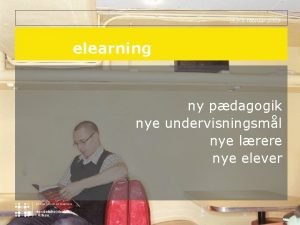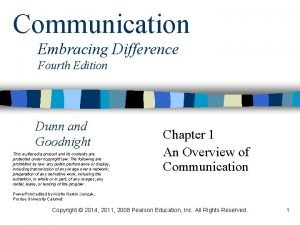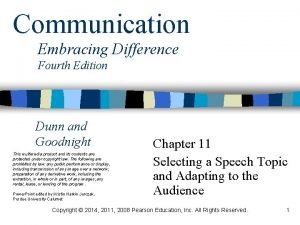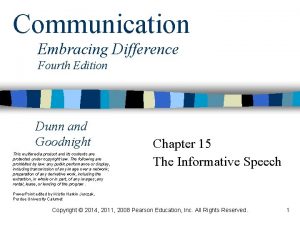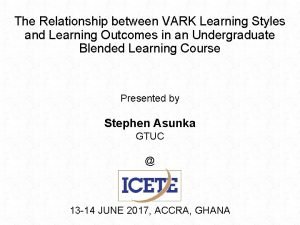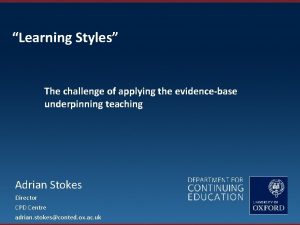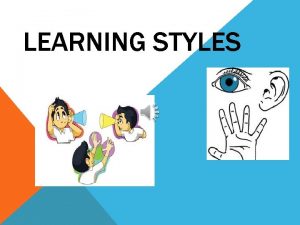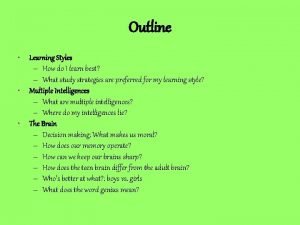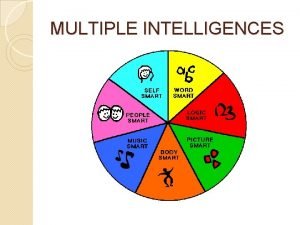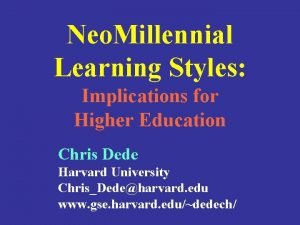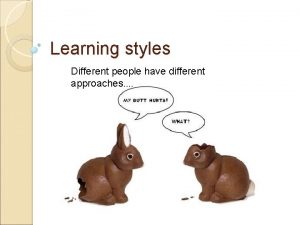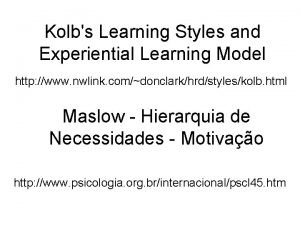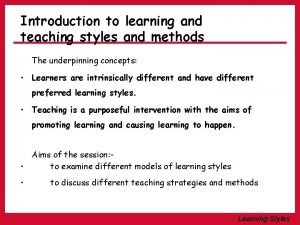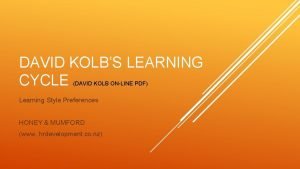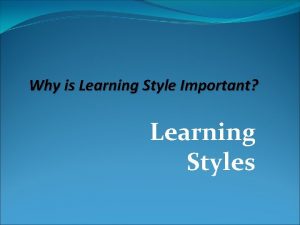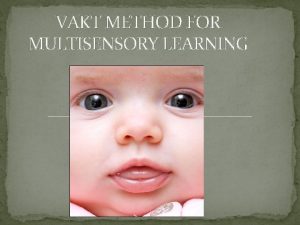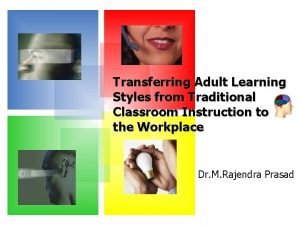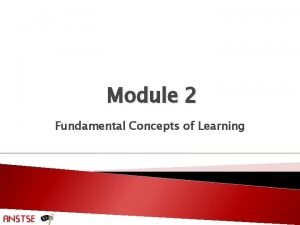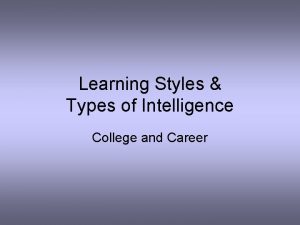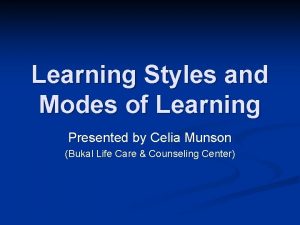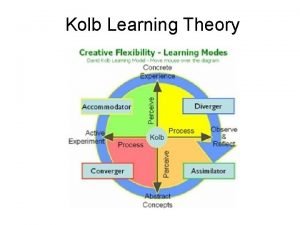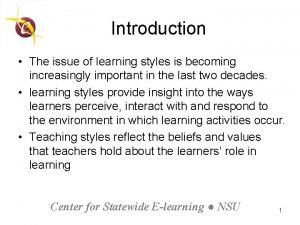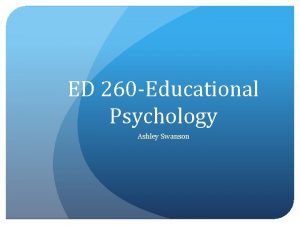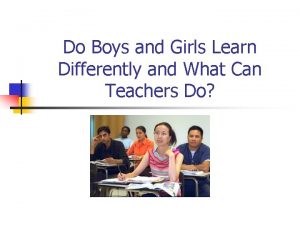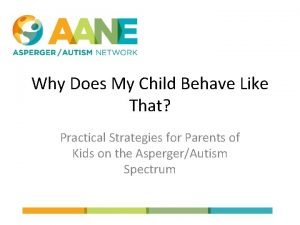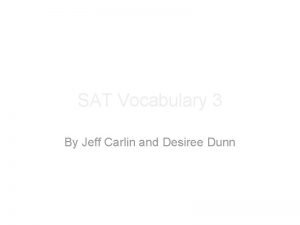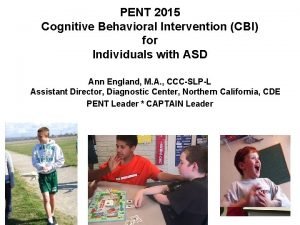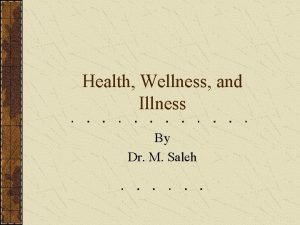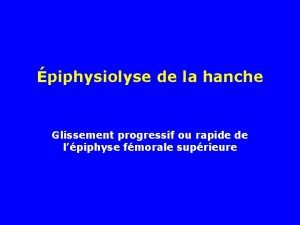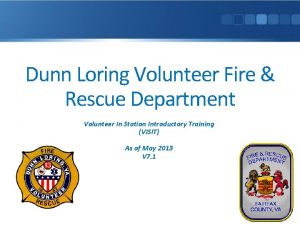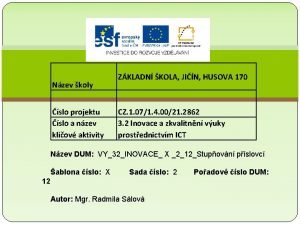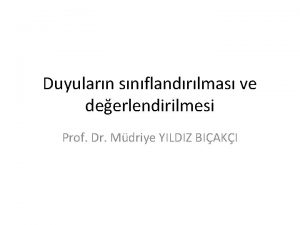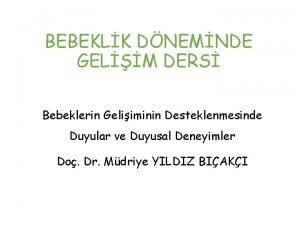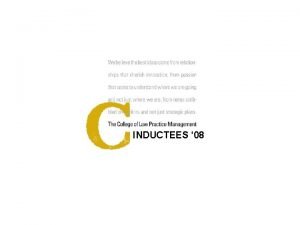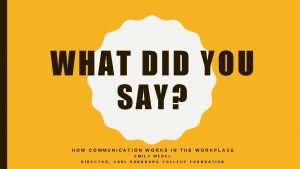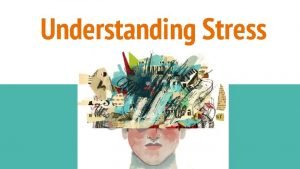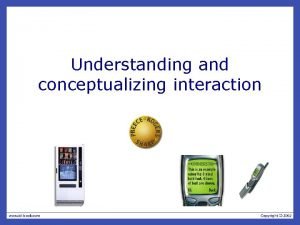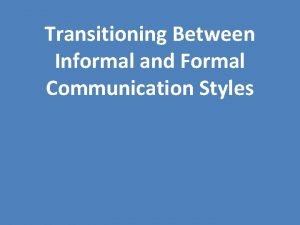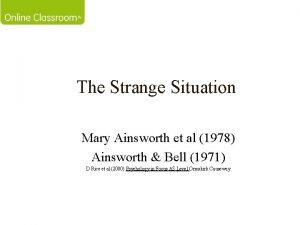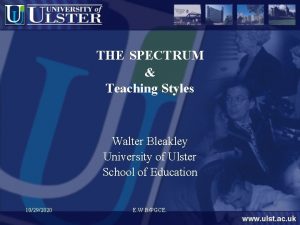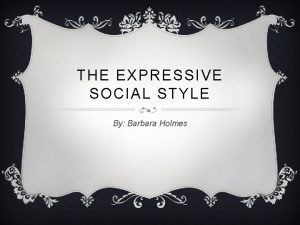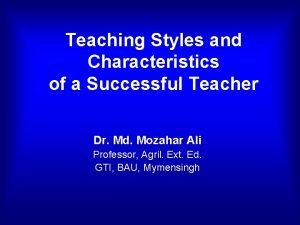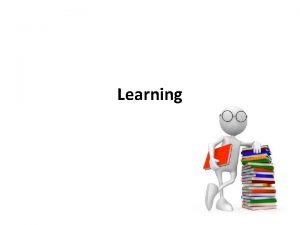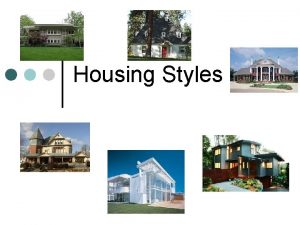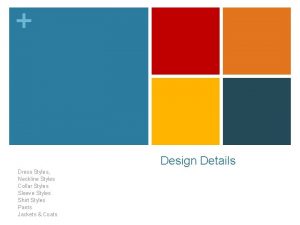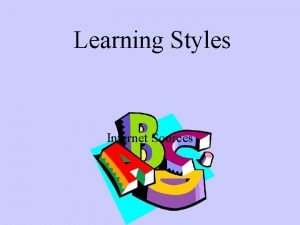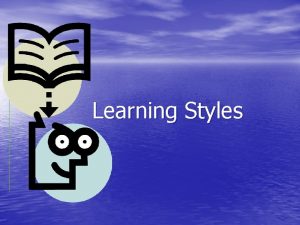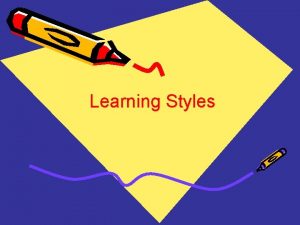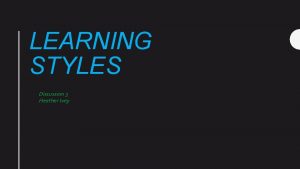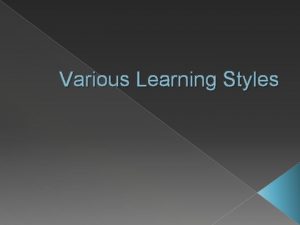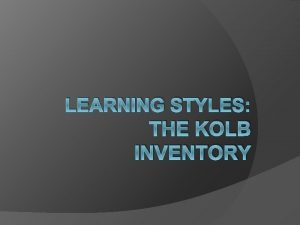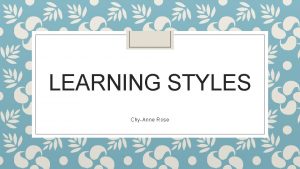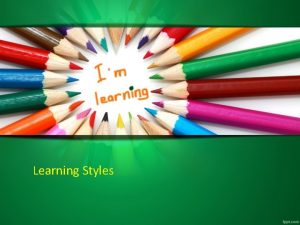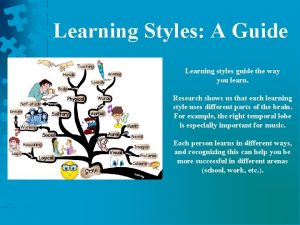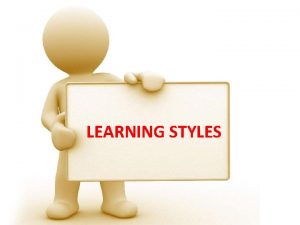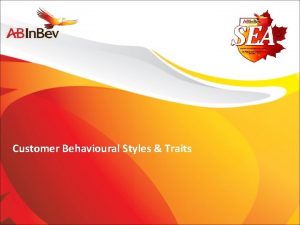Learning Styles Agenda Dunn Dunn Model Definition Learning

































































- Slides: 65

Learning Styles Agenda Dunn & Dunn Model

Definition • Learning Styles is the way in which the learner begins to concentrate on, process and retain new and difficult information.

Learning Styles We must emphasize the need for teachers to be aware that all children, regardless of their race, ethnicity, or gender have different learning styles.

One-Size-Fits-All Learning DOES NOT WORK!!! Not all children flourish under a single teaching style. The children who are not compatible with their teacher’s styles get left out.

• Diverse learning styles require diverse teaching styles!

Medley • Teachers should have a medley or variety of teaching styles. If a child does not master a skill the first time, try again, but not the same way you taught it the first time.

How do you like to learn? “I just don’t get it when I read the book; I have to hear someone explain it. ” “I have to write it down to remember it. ” “If I do the problem or procedure a few times, then I understand it. ”

Learning Styles and Preferences • Ask yourself: • How do I best process information? • How is information delivered to me? • How can I make information more accessible? • How can I learn and remember more effectively?

What is PEPS? • Productivity Environmental Preference Survey • Created by Dr. Richard Price at the University of Kansas and Drs. Kenneth and Rita Dunn at St. John’s University • They define learning style as “the way individuals begin to concentrate on, process, and retain new information. ”

PEPS Learning Styles Model • Environmental – – Sound Light Temperature Design • Emotional – – Motivation Persistence Responsibility Structure • Sociological – Self, Pair, or Team – Feedback from authority – Variety vs. routine • Physical – – Perceptual Intake Time Mobility • Psychological – Global/Analytic – Right/Left Hemisphere – Impulsive/reflective

PEPS Learning Styles Model

Which version did you prefer? • • • The visual, pictorial, colorful version? • Environmental – Sound – Light – Temperature • – Design Emotional – Motivation – Persistence – Responsibility • – Structure Sociological – Self, Pair, or Team – Feedback from authority – Variety vs. routine Physical – Perceptual – Intake – Time – Mobility Psychological – Global/Analytic – Right/Left Hemisphere – Impulsive/reflective • Or the straightforward list? • One version probably “looked” better to you, or seemed better organized or clearer. • This choice reflects your preferred processing style.

Sample Student, Sample Female 1980 Highlight the asterisks that show your score

Interpreting Your Profile • To learn new or difficult material: – Look for strengths and preferences, indicated by scores below 40 or above 60 – High motivation can overcome a strong preference (score 30 -40 or 60 -70) – You can’t really “overcome” a very strong preference (score 20 -32 or 70 -80). You must address elements with these scores to learn effectively.


Sound The extent to which the learner needs noise or quiet to aid the learning process.

Noise Level • About 20% of learners need a noisy environment • Females, in general, need more quiet while learning. • Need for sound increases during adolescence. • About 10 th grade, the need for sound returns to normal. • In older adults, the need for quiet increases.

The level of lighting required by the learner for optimum learning.

T E M P E R A T U R E The degree to which heat and cool effect the learner.

Light & Temperature • Low light relaxes and permits better concentration for 8 out of 10 who do not read well. • Being too hot or too cold can be an extreme distracter. • People tend to need more warmth as they age.

The learner’s preference formal or informal seating while learning.

Design • Design effects more than 70% of children. • 40% of youngsters require informal design. • Preference remains stable through elementary school. • In adolescence, students become increasingly informal. • Males more than females require informal.


Motivation The extent to which the student enjoys academic in a conventional classroom.

Motivation • Students permitted to work in their own learning styles perform better and try harder • Interest in the topic and the degree to which teacher’s and learner’s styles match greatly impact motivation • Preference for parental motivation tends to be developmental

Parent Motivation The degree to which the student wants parental involvement in his/her education.

Teacher Motivation Extent to which the learner needs instruction and feedback from the teacher.

Motivation • It is possible that students who get the least positive feedback from parents are the most parent motivated. • The older a student becomes, the less likely they are to be teacher motivated.

Persistence The extent to which the learner stays on task until the task is completed.

Persistence • • Present in more analytics Don’t like conversation breaks until through Don’t like lots of extraneous information Value time and do not want someone else to waste it

Responsibility The extent to which the learner does what he/she ought to do in an academic setting.

Responsibility • • 1. 2. 3. 4. Usually a gauge of conformity vs. nonconformity Four periods of nonconformity: Terrible “ 2’s”–lasts about a year 12 -14 – in some declines by 10 th grade – others remain entrenched in adolescent behavior well into 30’s Mid-life crisis Elderly

Structure The extent to which the student needs explicit, step-by-step directions to perform work.


Learning Alone (Self) The need for learning alone versus with others for best learning experience.

Pair The need for working with one other versus with others or by oneself for best learning experience.

Peers The need for learning with a peer group, with a pair, team, or oneself for the best learning experience.

Authority Figure Extent to which learner needs instructions and feedback from those in charge.

Team The need for learning with a team versus with a peer or by oneself for the best learning experience.

Variety Extent of desire for opportunity to learn through several different sociological methods.

Perceptual Auditory, Visual, Tactile and Kinesthetic preference or receiving stimuli.

Visual Remembers 3/4 of what is read or seen.

Visual • • • Up to 40% of the population are visual Strong sense of color May have trouble following lectures Need to see it to know it May have difficulty with spoken directions

Auditory Remembers 3/4 of what is heard.

Auditory • • 22% of adults are auditory More females than males Girls become auditory earlier than boys Approximately 10 -13% of population auditory • May have difficulty following written directions

Tactual Remembers 3/4 of what is written or manipulated.

Tactile • Reflects a need for busy hands • Often prefer computer to reinforce learning through sense of touch • May trace letters and words to learn spelling and remember facts

Kinesthetic Remembers 3/4 of what they do (through either whole body movement or involvement).

Kinesthetic • Requires whole body or ‘being’ involved • Learn better when physical activity is involved • Prefer experiential learning

Intake The need for food or drink while learning.

Time The impact of the chronological time of day on learning.

Mobility The capacity to sit still for long periods of time while learning.


Processing The reliance on global versus analytical style for processing stimuli.

Impulsive Characteristic of a global learner.

Reflective Characteristic of an analytic learner.

Global and Analytic Learning Styles: Based in Hemisphericity • Analytic (left hemisphere)— – – – – – Linear Concrete Sequential Logical Rational Verbal Temporal Objective Linguistic Detail-oriented • Global (right hemisphere)-– – – – Visual Holistic Simultaneous Subjective Non-verbal Intuitive Symbolic Emotional

Global/Analytic Indicators • Elements 1, 2, 4, 6, and 16 can indicate a global or analytic preference • Scores of 20 -40 or 60 -80 on THREE of the FIVE indicate a global or analytic preference • We all use both, but many people have strong or very strong preferences for one style or the other • Check your profile for these indicators!

Global and Analytic Styles in PEPS • Global Learners – Need • Sound • dim light • informal design • The overall picture – Are • Energetic, but are low persistent; need multiple projects and frequent breaks • Responsive to visuals and stories – Use color – Process in chunks or wholes – Need intake for maximum concentration • Analytic learners – Need • Quiet • Bright light • Formal design • Sequence from part to whole – Are • Highly persistent • Punctual • Reflective • Detail-oriented • Responsive to word meanings – Don’t intake while concentrating

IQ Study • 125 -135 • 135 -145 • Above 145 8 out of 10 Analytical 8 out of 10 Global 9 out of 10 Global In between A. and G. is an integrated brain. Not excluded by a teacher who is analytical or global.

What’s your score pattern? • Did you have only a few high or low scores? • Were the highs and lows just at or above 60 or just at or below 40? • Were most scores in the 4060 “it depends” range? • That’s typical!

So What? A recent American study concluded: “Children who fall behind in first grade have a 1 in 8 chance of ever catching up to grade level. ” (Joel, 1994)

We Learn: • 10% of what we read • 20% of what we hear • 30% of what we see • 50% of what we see and hear • 70% of what is discussed with others • 80% of what we experience personally • 95% of what we teach someone else Source: William Glasser

More study suggestions for the different learning style preferences • http: //www. metamath. com/lsweb/fourls. htm from Diablo Valley College in California • http: //www. vark-learn. com/english/page. asp? p=helpsheets from the VARK [Visual, Aural, Read/write, Kinesthetic) Learning Styles site • http: //www. sdc. uwo. ca/learning/? styles from the Student Development Centre at the University of Western Ontario • http: //www. delta. edu/tlc/TLCStudy. Support/learninglinks. htm Learning Styles and Strategies links from the Teaching/ Learning Center

Study Tips for Global and Analytic Learners • Global learners tend to – Be interested in the big picture – Seek patterns and relationships among details – Like to examine things from several angles at once – Use visual-spatial processing • Study tips for Global learners – – – – Get overviews of topics Use applications or examples Use visual or tactile models Work in small groups Seek variety of feedback Use color in paper, ink, etc. Use mnemonics • Analytic learners tend to – Be interested in details or components of the whole – Analyze details separately – Like to examine things one step at a time, in order – Use verbal or symbolic (such as math symbols) processing • Study tips for Analytic learners – Put details in a clear sequence – Use step-by-step procedures – Use written models and examples such as texts and handouts – Work alone (at first) – Write things down, take notes, make lists – Research for additional details
 Kognitive skemaer piaget
Kognitive skemaer piaget Agenda sistemica y agenda institucional
Agenda sistemica y agenda institucional Dunn and goodnights model of communication
Dunn and goodnights model of communication Dunn and goodnights model of communication
Dunn and goodnights model of communication Communication embracing difference
Communication embracing difference True colors learning styles
True colors learning styles Vark inventory
Vark inventory Education planner learning style
Education planner learning style Objectives of learning styles
Objectives of learning styles Outline of learning styles
Outline of learning styles 8 multiple intelligence howard gardner
8 multiple intelligence howard gardner 7 learning styles
7 learning styles Education styles
Education styles Objectives of learning styles
Objectives of learning styles 7 learning styles and vark similarities
7 learning styles and vark similarities Kolbs learning styles
Kolbs learning styles Communication styles analytical driver amiable expressive
Communication styles analytical driver amiable expressive Importance of knowing learning styles
Importance of knowing learning styles Teaching styles
Teaching styles Ciclo di kolb pdf
Ciclo di kolb pdf Conclusion of learning styles
Conclusion of learning styles Vakt method
Vakt method Adult learning styles
Adult learning styles Three types of learning
Three types of learning Tactile learner careers
Tactile learner careers Modes of learning
Modes of learning Kolb learning styles
Kolb learning styles Conclusion of learning styles
Conclusion of learning styles Multiple intelligences and learning styles
Multiple intelligences and learning styles Male vs female learning styles
Male vs female learning styles What is vark
What is vark Kari dunn buron
Kari dunn buron Abridge is to shorten as reiterate is to
Abridge is to shorten as reiterate is to Kari dunn buron
Kari dunn buron What i isearch
What i isearch High-level wellness example
High-level wellness example Peter dunn viagra son
Peter dunn viagra son Joseph dunn shark attack
Joseph dunn shark attack Epiphysiolyse
Epiphysiolyse Dunn loring volunteer fire department
Dunn loring volunteer fire department Teuer komparativ und superlativ
Teuer komparativ und superlativ Dunn duyu profili testi indir
Dunn duyu profili testi indir Duyusal süreçte dunn modeli
Duyusal süreçte dunn modeli Jj cavanaugh
Jj cavanaugh Juli dunn whitman college
Juli dunn whitman college Barbara dunn gensler
Barbara dunn gensler Dr scott dunn sandpoint idaho
Dr scott dunn sandpoint idaho Barbara becker gibson dunn
Barbara becker gibson dunn Justin dunn web designer
Justin dunn web designer Cuadro comparativo de e-learning
Cuadro comparativo de e-learning Pac learning model in machine learning
Pac learning model in machine learning Pac learning model in machine learning
Pac learning model in machine learning Agenda 21 definition
Agenda 21 definition Agenda setting definition
Agenda setting definition Chicago multiple nuclei model
Chicago multiple nuclei model Analytical intuitive functional and personal
Analytical intuitive functional and personal Coping skills
Coping skills Hci interaction styles
Hci interaction styles Haiku.
Haiku. Types of documentries
Types of documentries Scenario of formal communication
Scenario of formal communication In mary ainsworth's strange situation experiment
In mary ainsworth's strange situation experiment Walter bleakley
Walter bleakley Expressive social style
Expressive social style Teaching styles self-assessment tool
Teaching styles self-assessment tool The facilitator teaching style
The facilitator teaching style
